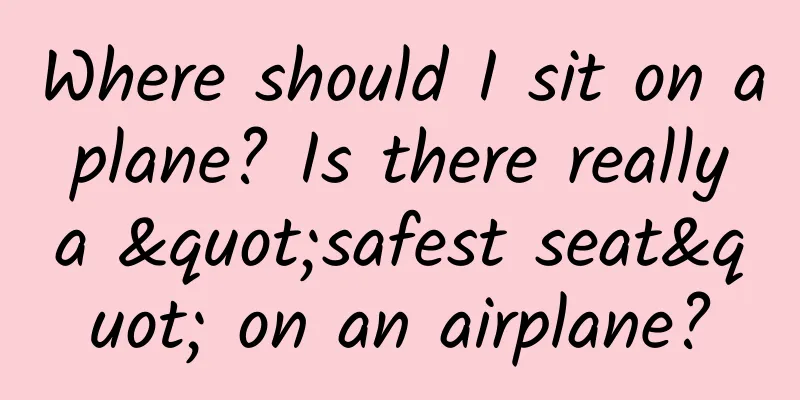Where should I sit on a plane? Is there really a "safest seat" on an airplane?

|
Nowadays, more and more friends choose to travel by plane, but we usually live on the solid ground, and being carried into the sky by such a large piece of metal as an airplane is inevitable to be a little nervous. In addition, the structure of the aircraft is complicated and difficult to understand, and the pilots look mysterious. There have been many myths and rumors about civil aviation circulating on various social media. Today is International Civil Aviation Day. Let us analyze them one by one. I believe that after reading this, you will feel much more at ease when flying. If the plane's engine fails, will you die? For the most common twin-engine aircraft in civil aviation, even if one engine fails, the aircraft can still rely on the other engine to reach the alternate airport. However, it is undeniable that single-engine flying is indeed very dangerous. The engine is a big thing, and if it stalls in the air, it will not only lose power, but also create air resistance, causing asymmetric power on both sides. The pilot must manipulate the aircraft's control surfaces to generate a torque to offset this asymmetry in order to keep the aircraft balanced and not spin. Therefore, the handling of engine failure has always been an essential training subject in pilot training, and only pilots who pass strict assessments can perform flight missions. What if all engines fail? That would be really hopeless. But there have been several miracles in aviation history: On July 23, 1983, Air Canada Flight 143 took off without enough fuel because the ground was confused about the imperial and metric system. The engine stalled midway, but the captain was a senior glider enthusiast. He glided in the air for 17 minutes and successfully landed the plane at an abandoned airport in nearby Gimli when the front landing gear could not be lowered. The plane was repaired and flew for another 25 years before being retired. It was nicknamed the "Gimli Glider". This record was broken on August 24, 2001 by Air Transat Flight 236, another Canadian (what?), which ran out of fuel in the air, and after both engines shut down, it glided for 20 minutes and landed at Lajes Air Force Base in the Atlantic Ocean. On January 15, 2009, in New York, US Airways Flight 1549 was hit by a flock of Canada geese (does this count as having something to do with Canada?) just after taking off, and both engines were damaged, but the captain was calm and decisive, and successfully landed the plane in the Hudson River. Such a big plane Are you really afraid of a few little birds? Since we are talking about the forced landing in the Hudson River, we have to talk about the bird strike incident. It is true that airplanes are afraid of birds. But you may not understand that such a large airplane and such a small bird are not of the same magnitude, and there should be no accident. But when you consider the speed, it is different. If a plane hits a bird weighing 200 grams and 20 centimeters long (roughly equivalent to a pigeon) at a speed of 200 meters per second, even if the bird's speed is negligible, it can instantly generate a 4-ton impact force at the point of impact. This is a very scary number, so there are various bird-repelling facilities around the airport, and special precautions are taken against foreign objects in the air such as kites, balloons, and drones. Damage to a JT8D engine after a bird strike. Source: Wikipedia, Photo: Plenumchamber The plane did not land at the airport it was supposed to land at. Is it an emergency landing? Sometimes you will hear someone on the phone: "Well, the plane made an emergency landing in Nanjing. There is a thunderstorm in Hangzhou now. We will go back when the weather is better." Just hearing the first half of the sentence may scare the person on the other end of the phone. However, the concepts are actually confused here. "Forced landing" refers to the crisis management of "forced landing, even if it is impossible to land", and failure is the end of the game, but even if it succeeds, there may be casualties, such as the landing gear cannot be lowered, or there is no runway at the place where it is to land. Due to weather or temporary airport/route control reasons, the aircraft sometimes lands at an airport other than the destination. This is called "alternative landing", which does not endanger life and is a routine operation in abnormal handling. You can't wish me a bon voyage on a plane. Because airplanes can't fly with the wind? There is a long-standing saying that you can say "bon voyage" to other means of transportation, but not to airplanes, because airplanes cannot fly with tailwinds. But "headwinds" obviously doesn't sound like a nice blessing, so we say "boon voyage". In fact, it is better to take off and land against the wind (the wind speed must be within the safe range) or without wind, but in the cruise phase, do you know how happy the pilots are to find a tailwind? The key point of takeoff and landing is to quickly obtain lift, which can be obtained more easily by flying against the wind. When cruising, the aircraft speed is already high enough, and there is no need to worry about lift at all. At this time, you only need to think about how to run fast, and that is to run fast with the wind. The speed of an aircraft relative to the ground is the sum of the wind speed and its own speed. Flying with the wind will save time and fuel (and ultimately money). Therefore, when designing a route, comprehensive considerations are made, and when it is possible to take advantage of the tailwind, it is given priority. Some routes may not seem to be a straight line between two points, but in fact they are faster and more economical, just because of the wind direction. You may be hesitant. Should we say "Bon voyage" or "Have a safe journey"? Actually, it doesn't matter! "Have a safe journey" is a good wish applicable to any means of transportation. At least it is not as annoying as "Have a safe journey" which has suddenly become popular in recent years. If you are really confused, just say "Have a safe cruise"! Aircraft routes are designed to avoid the sea as much as possible To avoid bad weather? Speaking of route design, we often see that the routes displayed on the TV in the plane are particularly biased towards land and avoid the sea. For example, when flying to Southeast Asia, we always want to stick to Vietnam. Is this because the weather at sea changes rapidly, so we have to avoid it? In fact, the cruising altitude of the aircraft is in the stratosphere, which is little affected by low-altitude weather. The transoceanic routes are designed in this way because of the flight risks. If an engine failure occurs at any point during the flight, the aircraft must be able to fly to an alternate airport with a single engine. We can infer that the freedom of how far offshore can be is related to the performance and reliability of the engine. The more advanced the technology, the straighter the route can be. In fact, many transoceanic routes now pass over the ocean (of course, not necessarily in a straight line, see the influence of wind direction in the previous article). The airplane emergency door handle is exposed right there. What if someone opens a door in the sky? In fact, the emergency door of the aircraft has a set of lock judgment logic to prevent it from being opened accidentally in the air. The judgment conditions include: multiple boarding doors are closed, any engine is running, the aircraft has airspeed, etc. Even without these safety measures, the door is designed to be pulled inward first and then pushed outward. At high altitudes, the cabin pressure is much greater than the external pressure, so the emergency door cannot be opened by just one person's curiosity. Besides, there are flight attendants and security personnel watching. The softer the plane lands, Does it mean the pilot is more skilled? A smooth landing is good, but too gentle a landing is problematic. If the plane lands too gently, the deceleration distance is sacrificed and there is no time to brake. In addition, the deceleration system of the plane needs to be triggered by the compression of the shock absorber struts when landing. If the landing is too gentle, the plane itself will not feel that it has not landed yet, and the speed brakes and brakes will not be triggered. In addition, there is the risk of skidding when there is water on the runway. Therefore, in terms of landing, civil aviation pays attention to "solid landing", neither slamming on the runway nor skipping on the runway. The plane shuts down its engines at high altitude So the sound heard by passengers is smaller? We often notice that after a plane takes off, the surroundings suddenly become quiet after a while. This is not because the plane has turned off its engine, but because takeoff and climbing require the greatest thrust, and when it reaches the cruising stage of level flight, it doesn't require too much effort. In addition, the aircraft's flaps are also a big source of noise. They must be lowered during takeoff, and they will be retracted after the aircraft climbs to its position, and the noise heard by passengers will also be reduced. This is definitely not what the marketing account says, that the aircraft will turn off its engine to save fuel when it flies to high altitudes... Image source: pixabay Open the porthole shades during takeoff and landing Is it to understand the flight direction of the aircraft? When the plane takes off and lands, the flight attendants will remind everyone to fasten their seat belts, straighten the seat backs, put away the small tables, and open the window shades for passengers sitting by the windows. These are all part of the safety measures. In case of an accident, the unobstructed seat spacing can help people evacuate, and the window of the window shade can be opened to observe the outside world: Is there a fire? Is it safe to escape from here? Of course, opening the window shade also meets the sightseeing needs during takeoff and landing, but this is just a benign side effect. However, please note that some airports are civil-military airports or have important military sites nearby, and they require the sunshades to be closed during takeoff and landing. At this time, do not use the above reasoning to argue with the flight attendant, otherwise you may have to have a good chat with the security personnel later... Why are there so many thorns on the wings? These thorns are called "discharge brushes" and are used to release the charge of the fuselage. Flying is friction with the air, and friction generates static electricity. If too much static electricity accumulates, it will wrap around the fuselage shell and interfere with communication signals and navigation systems. There is a law in physics called "tip discharge". The insulating medium near the tip with large curvature is more likely to break down, resulting in corona discharge. The discharge brush uses the tip discharge principle to release the static electricity of the fuselage through these spikes. Are these tips for safe flying true? Is there a safest seat? When flying, the most reliable safety tip is actually the "Safety Instructions" that we are too lazy to read or listen to. They are the experience gained from hundreds of lives lost since the civilian use of airplanes. Every word is of great importance...so if you haven't listened to it carefully, I really suggest you study it carefully next time. As for where to sit the safest, we would like to recommend a series of air crash investigation documentaries in Canada (here we go again!), "Air Crash". After watching it, you may have two thoughts: First, aircraft design and manufacturing and aviation safety systems have been gradually improving and perfecting with the blood of predecessors. Although an accident is a big deal, airplanes are indeed the safest means of transportation in the world. Second, although every accident has its reasons, overall, the randomness of flight accidents is still too strong, and the more reliable the aircraft and the more perfect the system, the greater the randomness of the accident. No matter where you sit, you may be killed indiscriminately by an air crash that seems to be targeting you. Therefore, the "safest seat" may only apply to specific types of accidents, and it is really hard to say whether the plane will have an accident, and which seats will be arranged to survive if an accident occurs. However, if we only look at the data, the tail of the plane, which is far away from the direction of the plane and where the black box is placed, has a slightly higher chance of survival in air crash statistics (as to whether this can be generalized, God knows), but the noise here is also quite loud. If we choose the back seat every time we take a plane, giving up the happiness of a peaceful sleep and waiting for an accident that may never happen in our lifetime, it is really not worth it. Planning and production Author|Qu Jiong Popular Science Writer |
<<: Boil the sea to make salt! Ancient "Shandong people" used "big helmets" to boil salt?
Recommend
Will Android devices and iPhones support Windows 10's "killer app"?
Last year, Microsoft launched the Windows Hello fe...
Tencent's ride-hailing code launches two new features: finally you can stay in bed a little longer
On June 3, Tencent's ride-hailing code launch...
Mobile phone photos and text messages have come back to life, but why can deleted data be recovered?
Popular Science Times reporter Chen Jie The itera...
OPPO Information Flow Advertising Operation Guide
OPPO information flow advertising is based on the...
When a junior operator is asked to organize an event, he needs to master the operation mentality
When junior operators are asked to organize an ev...
Bidding promotion has no effect. How to adjust Baidu bidding if it is not effective?
In 2021, many people say that Baidu bidding is di...
Heavy snow today | Why is it not cold when it snows but cold when it melts? Previous perceptions may not be accurate
The Big Snow solar term is the 21st solar term in...
Taichi jailbreak v1.2.0 released to crack iOS 8.1.2 in half a day
This morning, Apple officially released iOS8.1.2 ...
Behind the recall: Who is hacking the iPhone 6 Plus?
Ever since Apple released the iPhone 6 and iPhone...
Tencent operations expert, maybe her 15 tips can help you
How to operate well? Before you start: Five prepa...
The “traffic code” of brand self-broadcasting
Nowadays, short videos and live broadcasts are ve...
Monster Factory: Black and White Concept [HD]
Why should I learn grayscale coloring? Grayscale ...
Free Wi-Fi is prone to security issues and you should avoid online payments
Yesterday afternoon, on the "Financial Day&q...
Apple iOS 15 leak summary: In addition to new icons, new lock screen, new notifications, there are 3 major changes
If you are a qualified Apple fan, even if there a...
Chinese people are not suitable for drinking milk? 85% of Chinese people are lactose intolerant? You have misunderstood for too many years!
Rumor: "Chinese people are not suitable for ...









